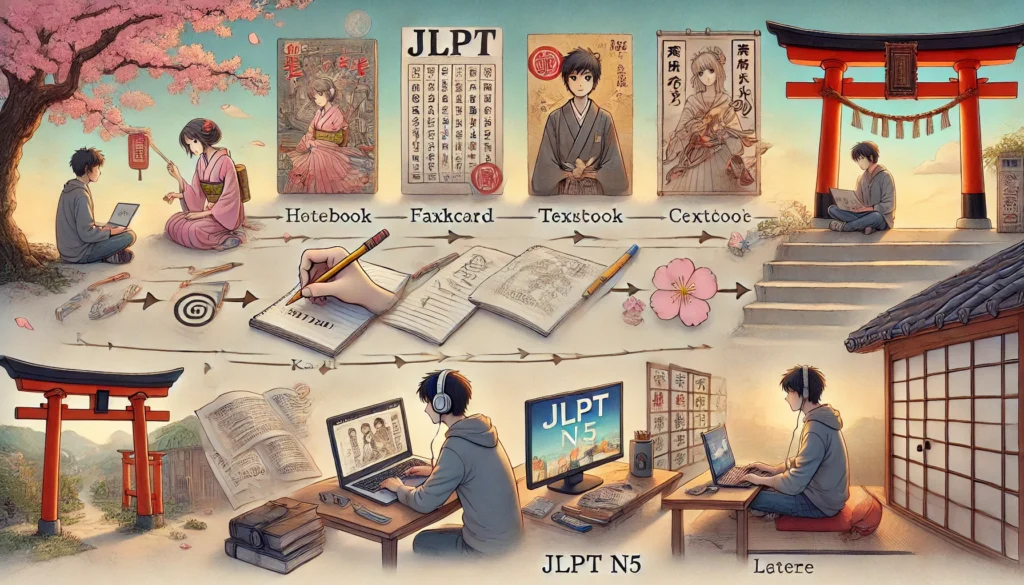Learning Japanese on your own is one of the most rewarding challenges you can take on. Whether you dream of traveling to Japan, watching anime without subtitles, reading manga in the original language, or even working in Japan, self-studying Japanese is absolutely possible—if you have the right approach.
Many learners give up too soon because they don’t know where to start, get overwhelmed by kanji, or follow inefficient study methods that lead to burnout. But you don’t have to make those mistakes.
This guide will show you the best way to study Japanese on your own, breaking it down into clear, actionable steps. You’ll discover the best resources, study techniques, and strategies to stay consistent and actually enjoy the process.
Let’s dive in!
Step 1: Learn Hiragana & Katakana First
Before anything else, you need to learn Hiragana (ひらがな) and Katakana (カタカナ)—the two fundamental phonetic alphabets of Japanese. Without them, you won’t be able to read even the most basic words.
Why Are Hiragana & Katakana So Important?
- Hiragana is used in almost every sentence and is essential for grammar.
- Katakana is used for foreign words, sound effects, and emphasis.
- Both are necessary for reading and writing in Japanese—Kanji alone is not enough.
Best Tools to Learn Hiragana & Katakana Quickly
- Download my free Hiragana & Katakana Cheat Sheet for a quick and easy reference guide.
- Dr. Moku’s App – Uses mnemonics to help you remember characters faster.
- Tofugu’s Hiragana & Katakana Guide – Offers visual memory tricks for each character.
- Anki Flashcards – Digital flashcards to reinforce recognition.
💡 Pro Tip: Master Hiragana & Katakana within 1–2 weeks before moving on to other aspects of Japanese.
Step 2: Choose the Right Beginner Textbook
Once you know the alphabets, it’s time to start learning grammar and sentence structure. The best way to do this is with a structured textbook designed for self-learners.
Best Beginner Textbooks for Self-Studying Japanese
- Genki I & II – The most popular textbook series for beginners, covering essential grammar, vocabulary, and listening exercises.
- Japanese from Zero! – A beginner-friendly option with a slower progression.
- Tae Kim’s Guide to Learning Japanese – A free online resource focusing on practical grammar explanations.
How to Use Your Textbook Efficiently:
✅ Read each chapter carefully and take notes.
✅ Practice writing example sentences based on what you learn.
✅ Use the included audio files to improve your listening skills.
✅ Review previous lessons regularly so you don’t forget key points.
💡 Pro Tip: Avoid overloading yourself! Stick to one textbook instead of jumping between different ones.
Step 3: Start Learning Kanji the Smart Way
Kanji (漢字) can seem intimidating at first, but with the right approach, it becomes manageable—and even fun!
Why You Shouldn’t Just Memorize Random Kanji
Many learners make the mistake of trying to memorize kanji one by one without context. This leads to frustration because kanji often have multiple readings and meanings. Instead, you should:
- Learn kanji in context (with words and sentences).
- Use a systematic approach to break down complex characters.
- Practice recognition, not just writing (writing is important, but recognizing kanji in reading is more useful for beginners).
Best Resources for Learning Kanji
- WaniKani – A highly effective kanji-learning platform using spaced repetition and mnemonics.
- Kanji Study (App) – Great for learning how to write kanji correctly.
- Remembering the Kanji (Book by Heisig) – Focuses on learning kanji meanings before readings.
- Anki Kanji Decks – Use pre-made flashcard decks for efficient review.
💡 Pro Tip: Start with 100 basic kanji, then gradually increase. Don’t rush—slow, steady progress is better than burnout.
Step 4: Improve Your Listening Skills Early On
Listening is one of the most overlooked but critical skills in language learning. The sooner you expose yourself to native Japanese speech, the faster you’ll adapt to its rhythm and pronunciation.
How to Train Your Ears for Japanese
🎧 Listen to Japanese every day, even if you don’t understand it yet.
📝 Shadowing Technique: Repeat words and sentences immediately after hearing them.
🎙️ Speak out loud to get used to forming Japanese sounds.
Best Listening Resources for Beginners
- JapanesePod101 – Structured lessons with native speakers.
- NHK Easy News – Simple Japanese news with audio.
- YouTube Channels – Learn from real conversations (Try “Nihongo no Mori” for grammar explanations).
- Anime & Drama – Watch with Japanese subtitles, not English!
💡 Pro Tip: Set a goal to listen to at least 10 minutes of Japanese daily.
Step 5: Build Your Vocabulary with SRS & Context-Based Learning
A strong vocabulary is essential for fluency, but the best way to learn Japanese words is in context rather than isolated lists.
Best Methods for Learning Vocabulary
- Spaced Repetition Systems (SRS):
- Anki
- iKnow!
- Reading Simple Japanese Texts:
- Graded Readers (designed for learners).
- Manga with Furigana (e.g., Yotsubato!, Shirokuma Café).
- Writing Your Own Sentences:
- Create daily journal entries in Japanese.
💡 Pro Tip: Don’t just memorize words—learn how they’re actually used in sentences!
Step 6: Practice Speaking & Writing Regularly
One of the hardest parts of self-studying is lack of speaking practice. But you can still improve on your own!
Ways to Practice Speaking Alone
- Shadowing – Repeat after native speakers.
- Think in Japanese – Describe what you see in Japanese throughout the day.
- Self-Recording – Record your voice and compare it to native pronunciation.
Ways to Practice Writing
- Lang-8 / HelloTalk – Get feedback from native speakers.
- Keep a Japanese journal – Write a few sentences daily.
- Text native speakers – Even short messages help improve fluency.
💡 Pro Tip: Speaking is more important than perfect grammar—just start talking!
Final Thoughts: Stay Consistent & Keep It Fun!
Learning Japanese on your own is a long journey, but it’s 100% possible if you stay consistent and enjoy the process.
🚀 Your Next Steps:
✅ Download my free Hiragana & Katakana Cheat Sheet to kickstart your learning.
✅ Set a realistic daily study schedule and stick to it.
✅ Focus on one skill at a time (don’t overwhelm yourself).
✅ Keep going—even when it feels hard!
Your Japanese adventure starts today—頑張って (Ganbatte)! 🎌




